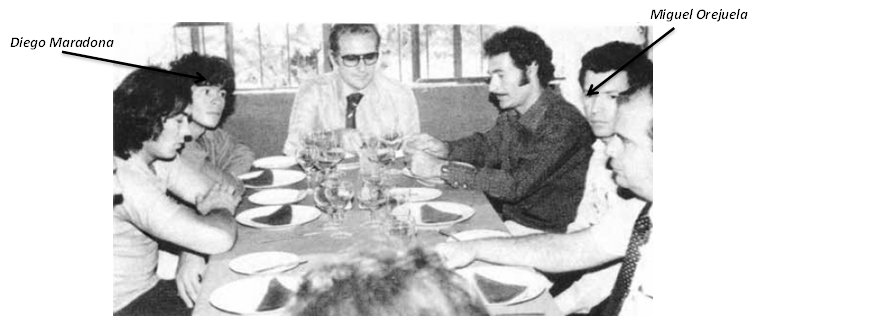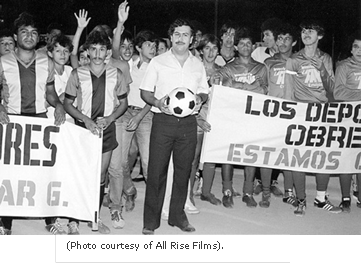The effects on the Clubs and the League
As seen before, the drug cartels invested their illicit money into football clubs so that they could launder it and legitimise the cash. However they also had a passion for football which compelled the drug lords to improve their local team and give back to the local community, in which they once belonged.
The
huge amounts of money being pumped into the football teams,
allowed them to improve their facilities and buy better players.
Many clubs had a new sense of financial stability, which gave
them a foundation to improve on the football pitch. Shortly
after the Cali Cartel bought América de Cali in 1979, they
purchased some star Argentine players like Julio Falcioni in
1981 and Ricardo Gareca in 1985. The team they had in the 1980’s
was seemingly almost unbeatable as they won five consecutive
league titles from 1982-1986. (América
de Cali ganó campeonatos gracias al dinero del
narcotráfico)Not only did they excel in
Colombia, but they shined on the continent as well. They were
three times runners up of the main South American football
championship, the Copa Libertadores, in ’85, ’86 and ’87,
representing the blooming quality of Colombian football. The
wealth of América de Cali under Miguel Orejuela is highlighted
by the fact that in 1980, Diego Maradona was about to sign for
the club. Miguel Orejuela invited Maradona to lunch in his
mansion and offered him a huge, lucrative contract of $500,000 a
month. However, after much thought, Maradona rejected the
contract offer and signed for Boca Juniors of Argentina instead. (El
Mundo, 2008) The picture below shows
Maradona having lunch with Miguel Orejuela, in the midst of
contract negotiations. 
It was not just América de Cali enjoying footballing success. Atletico Nacional of Medellín was booming under the influence of Pablo Escobar. In 1989, they managed to win the Copa Libertadores, beating Olimpia of Paraguay in a penalty shootout in Bogotá. Although there was a lot of controversy in the way in which they won the tournament, it is indisputable that this win represented a pinnacle of the huge growth in the quality of football played by Colombian teams, as Atletico Nacional, managed to win what the various drug lords with different clubs had desired so much. (Duben, 2013) The champions of the 1989 Copa Libertadores were a side with many of Colombia’s best footballers. René Higuita, Andrés Escobar and a young Faustino Asprilla, would all play a huge part in the successful Colombian National Team of the early 1990’s. These home-grown players were earning more and more money (provided by the Medellin cartel), (Duben, 2013) thus allowing them to focus on training and improving their individual game. As a collective, the team had high morale and chemistry which allowed them to play scintillating football.
Aside from América de Cali and Atletico Nacional, Millionarios of Bogotá were also reaping the successes from the investment of the Medellin Cartel drug lord, José Rodríguez Gacha. Millionarios were in a financial crisis in the later 1970’s to early 1980’s, with 1.75 pesos being spent for every 1 peso coming in. Nicknamed “El Mexicano”, Gacha purchased a large part of the club in 1982 in order to give the league more competition, giving it a huge influx of capital. (Así fue cómo el 'Mexicano' se tomó a Millonarios, 2012) With this money, the club managed to win back-to-back league titles in 1987 and 1988. Smaller teams not used to success also found benefits from the investment of drug lords. Independiente Santa Fe of Bogota was bought by Fernando Carillo of the Cali Cartel and Deportivo Pereira was purchased by the multimillionaire Octavio Piedrahita who had links with Pablo Escobar. This shows the effect that the drug cartels had on the Colombian football league, not just with the top teams but also with smaller clubs fighting for survival.
The positive effects on grassroots football
The
illegal money from the drug lords did not just benefit the first
division of Colombian football. It had a more profound influence
on society as a whole, through the investment into grassroots
football. Many of the prolific billionaire drug lords came from
deprived backgrounds, growing up in a life of street crime and
poverty.  They wanted to give something back to the local
community. Pablo Escobar was the most keen drug kingpin, to want
to support the impoverished locals. He built over 50
professional looking football pitches in the slums of Medellin
and would pay for the equipment necessary for the inhabitants of
these slums to play.
(Pablo Escobar, el auge y el
entierro del fútbol colombiano, 2013)The
local children often had little access to education and
opportunities. The football pitch gave them tangible aspirations
and hopes to make it out of the tough and violent slums. Some of
the most talented Colombian footballers of the modern day grew up
playing football on the pitches built with money provided by Pablo
Escobar, showing the long lasting positive influence on society by
the drug cartels, still evident today. (Jeff
Zimbalist, 2010). The picture above shows
Escobar holding a football with young footballers from the
Medellin slums. It shows how he helped them by giving them the
necessary equipment to play football with. It also shows how they
looked up to him.
They wanted to give something back to the local
community. Pablo Escobar was the most keen drug kingpin, to want
to support the impoverished locals. He built over 50
professional looking football pitches in the slums of Medellin
and would pay for the equipment necessary for the inhabitants of
these slums to play.
(Pablo Escobar, el auge y el
entierro del fútbol colombiano, 2013)The
local children often had little access to education and
opportunities. The football pitch gave them tangible aspirations
and hopes to make it out of the tough and violent slums. Some of
the most talented Colombian footballers of the modern day grew up
playing football on the pitches built with money provided by Pablo
Escobar, showing the long lasting positive influence on society by
the drug cartels, still evident today. (Jeff
Zimbalist, 2010). The picture above shows
Escobar holding a football with young footballers from the
Medellin slums. It shows how he helped them by giving them the
necessary equipment to play football with. It also shows how they
looked up to him.
The effect on the Colombian National Team
The newly found success in Colombian league football was consequently transmitted onto the national team. As mentioned above, the Colombian stars were on large salaries provided by their clubs and had lucrative sponsorship deals, especially during the 1990 and 1994 world cups. (Jeff Zimbalist, 2010) They had some of the best international coaches and facilities at their clubs, which allowed them to improve their game massively. They were also playing on the biggest stage of South American club football, giving them the experience of playing highly competitive football. Coming together to play for Colombia, the players had great chemistry which allowed them to cement a mesmerising, creative and slick playing style. The 1-1 draw against England at Wembley stadium in May 1988 marked the beginning of a new golden era for the Colombian national team. It showcased the dominant football played by Colombia to the world.
In the 1990 FIFA World Cup, Colombia got the round of 16, losing to Cameroon after a Roger Milla goal, demonstrating the progress made by the Colombians. However it was the qualification campaign for the 1994 FIFA World Cup which was the zenith of Colombian football for a generation. World renowned players like: Carlos Valderrama, Andrés Escobar, Faustino Asprilla, René Higuita, Adolfo Valencia and Freddy Rincón, played their best fotoball while attracting attention from the European elite. They qualified for the World Cup with ease. The effect that the drug lords had on the players is summed up well by Coghlan, claiming that “In the dying minutes of a crucial World Cup qualifying game in Barranquilla, watched by the entire cabinet and most of the country, Colombia scored a dramatic, match-winning goal. The scorer then publically dedicated his goal to the Rodríguez Orejeuala brothers, the unseen financiers of América de Cali, the football club that gave him his first break.”[1] This summarises well the positive impact of the cartels in financing the careers of young footballers.
